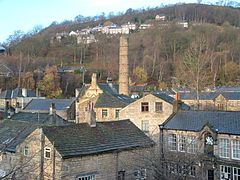Hebden Bridge
| Hebden Bridge | |
|---|---|
 Over the rooftops of Hebden Bridge |
|
| Hebden Bridge shown within West Yorkshire | |
| Population | approx 4,500 |
| OS grid reference | SD993273 |
| • London | 170 mi (270 km) SSE |
| Civil parish | |
| Metropolitan borough | |
| Metropolitan county | |
| Region | |
| Country | England |
| Sovereign state | United Kingdom |
| Post town | HEBDEN BRIDGE |
| Postcode district | HX7 |
| Dialling code | 01422 |
| Police | West Yorkshire |
| Fire | West Yorkshire |
| Ambulance | Yorkshire |
| EU Parliament | Yorkshire and the Humber |
| UK Parliament | |
Hebden Bridge is a market town which forms part of Hebden Royd in West Yorkshire, England. It is in the Upper Calder Valley, 8 miles (13 km) west of Halifax and 14 miles (21 km) north-east of Rochdale, at the confluence of the River Calder and the Hebden Water.
In 2004, the Calder Valley ward, covering Hebden Bridge, Old Town, and part of Todmorden, had a population of 11,549; the town itself has a population of approximately 4,500.
The original settlement was the hilltop village of Heptonstall. Hebden Bridge (Heptenbryge) started as a settlement where the Halifax to Burnley packhorse route dropped into the valley and crossed the River Hebden where the old bridge (from which it gets its name) stands. The name Hebden comes from the Anglo-Saxon Heopa Denu, 'Bramble (or possibly Wild Rose) Valley'.
Steep hills with fast-flowing streams and access to major wool markets meant that Hebden Bridge was ideal for water-powered weaving mills and the town developed during the 19th and 20th centuries; at one time Hebden was known as "Trouser Town" because of the large amount of clothing manufacturing. Drainage of the marshland, which covered much of the Upper Calder Valley before the Industrial Revolution, enabled construction of the road which runs through the valley. Before it was built, travel was only possible via the ancient packhorse route which ran along the hilltop, dropping into the valleys wherever necessary. The wool trade was served by the Rochdale Canal (running from Sowerby Bridge to Manchester) and the Manchester and Leeds Railway (later the Lancashire and Yorkshire Railway) (running from Leeds to Manchester and Burnley).
...
Wikipedia

